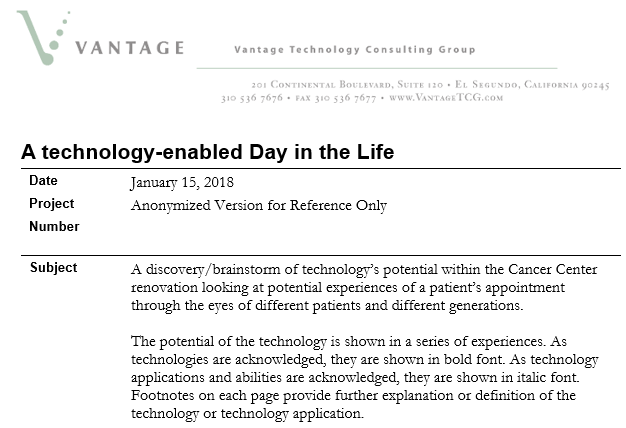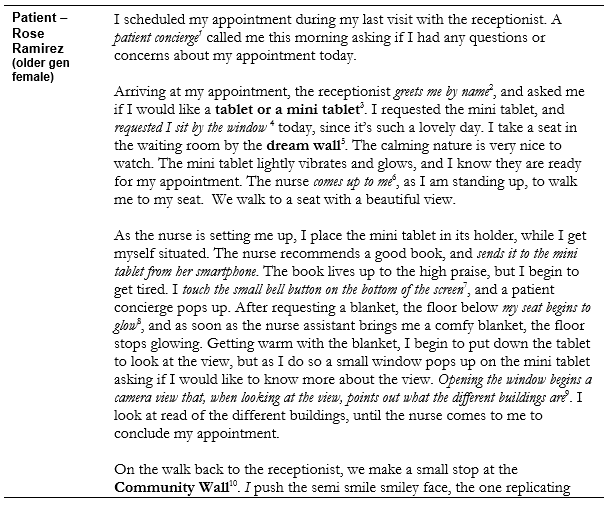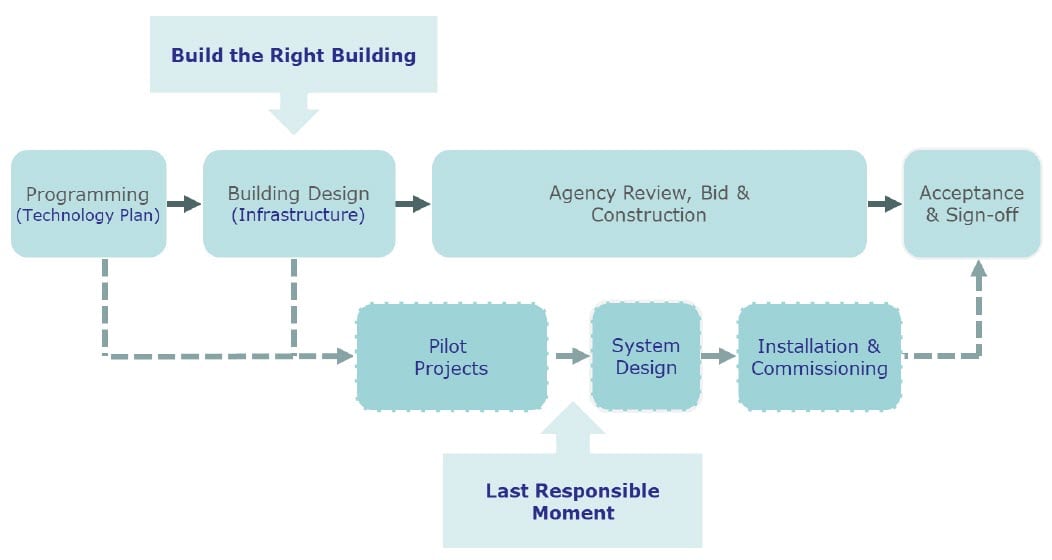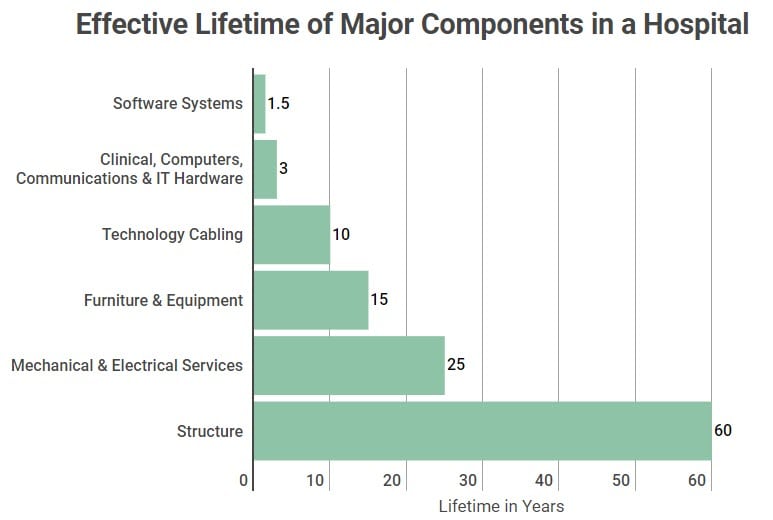Why is Technology Visioning Important in the Healthcare Industry?
What is the hospital of the future going to look like? How do you build a cutting-edge facility when it takes between six and ten years to design and build a new hospital? What healthcare technologies will be relevant in the next 10 to 20 years? Which of today’s cutting-edge technologies will be obsolete when the facility opens? How do you anticipate and plan for new technologies? How can emerging technologies deliver world-class patient care, and improve the patient experience and outcomes at a reasonable cost?
These and other questions are on the minds of healthcare executives, organizations and architects as they plan to design and build the next generation of new medical facilities that will last for the next 25 to 50 years or longer. The challenge with technology – both software and hardware systems– is that it has a relatively short lifespan of 3 to 5 years at most when compared with the other components that make up the building, and so facilities must be designed not only to support the latest technologies when they open but also to be able to support many technology additions and upgrades in the future.
Since it can take up to 10 years to design and build a new hospital facility, the best way to approach this challenge is to develop a comprehensive Healthcare Technology Visioning Plan that serves as a guideline for the medical organization stakeholders, architects and construction team.
Vantage has led a number of technology visioning projects in the healthcare industry, and this post describes our view of the “Anatomy of a Healthcare Technology Visioning Plan”.
Overall Goals of the Healthcare Technology Visioning Plan
The overall aim for the Technology Visioning Plan is to determine what technologies, and integrations between technologies, will be implemented in the new Hospital or Medical Facility. The final output of the vision is typically documented in a Technology Plan that identifies the technologies to be used at the new facility and provide a framework and schedule for the implementation and integration of each of these technologies.
A secondary goal for the Technology Visioning Plan is to provide a basis for the design of the technology infrastructure so that it provides the flexibility, expandability and ease of management needed to support many future generations of technologies throughout the Hospital. The ideal plan should avoid making any unnecessary decisions that may preclude the implementation of a future technology without understanding the full impact of the decision.
Our approach to Technology Visioning Plan includes the following steps:
- Establish the organization’s current technology baseline and future plans
- Conduct a series of stakeholder Visioning Workshops
- Produce the draft Technology Plan
- Finalize and promote the Technology Plan
- Plan for the Future
Let’s explore each step in more detail.
Establish the Current Technology Baseline
As we start a project, it is critical for us to gain an understanding of the organization’s current state of technology and gather information around future technology plans. This ensures that our visioning process is closely aligned with the organization’s current state and future goals.
After we review the information, we go onsite to meet with the appropriate stakeholders and tour the facilities to fill in the gaps and validate our understanding. The review typically consists of physical inspections, meetings with key departments and observations of their primary activities.
This phase typically takes 4 to 6 weeks based on gathering the information in a reasonable time frame and conducting the onsite visits.
Conduct a Series of Visioning Workshops
In this phase, we schedule a series of Visioning Workshops that typically cover the key areas in a hospital or medical facility including:
- Inpatient experience
- Outpatient experience
- Imaging and Interventional Services
- Lab, Pharmacy and other Clinical Support Departments
- Emergency Department
- Information Technology, Biomedical and Engineering
- Administration, Finance and Operations
- Research and Education Mission, if applicable
Instead of just asking or telling the organization what technologies to use, our workshops are designed to help the stakeholders make informed and future-looking technology decisions. We generally refer to these meetings as “Day in the Life” reviews that examine the workflows, processes and technologies that can improve the life of a patient, nurse, doctor or family member.
We approach the projects with a blank slate and emphasize that the stakeholders focus on workflow and communication rather than specific technologies, since we anticipate the technologies themselves may change (sometimes more than once) before the building opens.
In a recent project, one Day in the Life scenario examined the potential of technology within a Cancer Center’s appointment process through the eyes of several patients with different backgrounds and ages.

Example Day in the Life Scenario
The deliverables from these workshops are a series of Use Cases that document the the key processes in each area and describe how technology systems should be deployed in the new facility to support the organization’s goals.

Example Use Case for a Day In the Life Scenario
This phase typically takes 3 to 4 months depending on the number of stakeholder groups, the number of visioning meetings and the availability of personnel.
Produce the Draft Technology Plan
In this phase, we take the Use Cases developed from the Visioning Workshops and translate them into a comprehensive Technology Plan. We will then circulate the draft plan to the key stakeholders, gather any comments and feedback, and make final changes to the report.
This phase typically takes about 4 weeks to review and update the Plan.
Promote the Findings
The next phase is the presentation of the final Technology Visioning Plan. We will work with the key members of the project team to develop strategies to present and promote the report to the organization’s leaders and stakeholders. It is important to get buy-in from all stakeholders before proceeding since successful implementation of technology will be part of the building project for the next 10 years or more.
Plan for the Future
Our Healthcare Technology Visioning Plans have a window of applicability ranging from 5 to 15 years or longer, and as such must be viewed as a living document that guides the planning and design until the hospital is commissioned. Our “Last Responsible Moment” approach to technology allows us to accommodate multiple generations of technology by planning for a flexible infrastructure that will support the technologies selected for installation as close to the opening date of the hospital facility as possible. In other words, we know technology is going to change before the building is opened, and we delay final technology implementation decisions until the latest responsible time without impacting the construction plans.

Flow for Building the Right Building with the ‘Last Responsible Moment’ for the Technology and Infrastructure
For any new systems that are planned to be introduced into the new hospital, we recommend that pilot programs be developed to prove that the technologies are effective. The pilot programs are also important for developing processes, and for training and acclimating staff to the new systems prior to their transfer into the new facility.
The Healthcare Technology Visioning Plan should be also reviewed on a regular basis during the design and early construction phases to continue to test the assumptions and incorporate any new technologies, workflows and processes that may emerge.
What Makes for a Successful Healthcare Technology Visioning Project
Based on our experience with other Technology Visioning projects, we have identified three keys to a successful Healthcare Technology Visioning project:
- Experienced project team – We staff our technology visioning team with team members who are well-versed in strategy, systems and infrastructure. We have experts with experience in project management, visioning, clinical systems, workflow planning and integration, IT infrastructure, audiovisual, low voltage, commissioning, modelling and constructability.
- Single point of client contact – The single point of contact is critical for organizing, scheduling and assisting in the management of visits and meetings to create and produce the plan.
- Committed and engaged client team – We need active participation from the stakeholder groups to participate and contribute in all meetings, and to complete any reasonable homework assignments assigned as preparation for the meetings.


